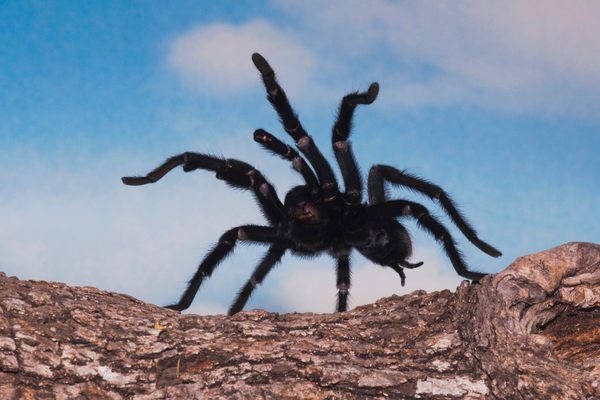Parched earth crunches under our boots as we walk across the eastern Colorado plains. It’s a late September day, and a vast expanse of cracked dirt—dappled with an occasional green spike of yucca and a scattering of yellow-flowering rabbitbrush—stretches out ahead of us.
“Found one!” calls out entomologist Jackie Billotte, eagerly beckoning to her colleagues as she pokes at a quarter-sized hole in the dirt with a twig. She’s hoping to lure out the female Aphonopelma hentzi, commonly known as the Oklahoma or Texas brown tarantula, who is in the mood for love. This time of year, thousands of frisky males set out in search of females like this one, who are holed up in their burrows. Males can travel up to a mile a day, leading researchers to coin this movement a “mate-gration.”
Billotte hopes the lady spider in the burrow might just mistake her stick for a knocking suitor and pop up to say hello. But then she catches a glimpse inside. “Nope, she’s not coming out,” she says. “I see an egg sac, so she’s already mated.”
Billotte, a doctoral candidate in agricultural biology at Colorado State University, isn’t just tricking females for fun. She’s on a mission to create a GPS map of the tarantula burrows in the area, which will help her better understand the current population size. She’s joined by her research colleagues from the Butterfly Pavilion, a Denver-based invertebrate zoo focused on helping people better appreciate Earth’s creepy-crawlies.
Moments later, the Butterfly Pavilion’s entomology manager, Francisco Garcia Bulle Bueno, spots a roving male approaching a nearby burrow. “This is the first time I’ve actually seen this,” he says, entranced with the suspense of the moment.
Tap-tap-tap-tap-tap. One of the male’s front legs raps gently against the web covering the hole. Tap-tap-tap-tap-tap.
Suddenly, a female springs out of her burrow. The two spiders embrace, intertwining into a ball of legs locked in an ancient dance. The profoundly intimate moment is overshadowed only slightly by the circle of humans murmuring expletives like, “Holy shit!” and “This is so f-ing cool!”
After a minute or so, the pair starts to separate. It’s a moment of truth for the male, who in tarantula tradition, now has a 30 percent chance of becoming lunch.
“Don’t eat him, please don’t eat him,” Billotte pleads in a whisper.
As it turns out, the male got lucky twice that day. The pair amicably parts ways and the female dives back into her burrow, promptly webbing the opening back up.
Despite his narrow escape, the male won’t last much longer. Males of this species take seven to 10 years to mature, hiding away in their burrows until they’re ready for the mating match of their lives. In order to better travel the relatively vast distances in search of mates, he has grown longer legs, plus hooks to defend himself from carnivorous females. But these accessories come with a cost. He’ll die during his next molt. Females, however, can live up to 30 years.
Despite these long lives and a range that extends from Colorado to Louisiana, we know surprisingly little about brown tarantulas—including how they survive the subzero winters and where their tiny spiderlings live. Researchers have a long list of questions to answer, but two big tasks stand out. First, they want to establish a baseline for the current population size, hence the burrow density surveys. Second, they want to understand how many get squished when their heroic quests cross Colorado Highway 109.
To answer that question, researchers set up tarantula-proof fencing to funnel the spiders into tunnels passing safely under the roadway, in partnership with the Colorado Department of Transportation. Mounted cameras track how many spiders are successfully diverted through the culverts, but to get the full picture, a crew also has to survey the scene first hand. Every weekend during the mate-gration, field technicians Gabe Rodkey and Spencer Marshall from the Butterfly Pavilion slowly drive down the highway to tally the tarantulas crossing over the road. On this September day, they’re joined by Garcia Bulle Bueno and Billotte, along with Chris Schneider, a veterinarian who expanded his focus from cats and dogs to help with tarantula research.
Unlike humans, who rely on musculature to move, tarantulas and other spiders use hydraulics powered by hemolymph, a fluid that circulates throughout their bodies. When it’s hot outside, the hemolymph thins, making it harder to coordinate moving all those legs. But when it’s too cool, the fluid becomes viscous, stiffening their legs. That’s why cool but not chilly early evening temperatures lure out the lusty wanderers, making it the perfect time for road crew research.
It only takes a few moments on the two-lane highway before the caravan pulls to the shoulder. Everyone jumps out to encourage two tarantulas to complete their crossing under threat of oncoming traffic. Billotte cringes as one tarantula narrowly escapes. The male is straddled by a car, a horse trailer, a gravel truck, and two pickups. When the dust clears, Billotte escorts him the rest of the way across. “C’mon buttercup,” she says encouragingly.
Some were not as lucky. Marshall bends to peel a flattened one off of the asphalt. That unfortunate gentleman is number 30 in this year’s squashed tally. The live count is more optimistic, reaching more than 90.
As the day turns to night, Billotte and Garcia Bulle Bueno take to the nearby fields of the Comanche National Grasslands. Here tarantulas and other spiders such as the smaller wolf spider are particularly plentiful. Female tarantulas come out at night, which makes them easier to observe. Everywhere Garcia Bulle Bueno walks, his headlamp illuminates the reflective eyes of hundreds of wolf spiders. He calls it a magical “field of green diamonds.” Most people who travel through this place during the day have no idea how special it is, says Garcia Bulle Bueno.
Soon, his headlamp rests on a female tarantula who has ventured out of her burrow. He switches his light to red, a color spectrum spiders can’t see, so as not to disturb her. Then, he slowly kneels down to get a closer look, and beams a broad smile.
“Yes,” he says, “this is a sacred spot.”


